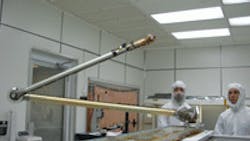Growing asparagus on Mars
Summer gardening often results in a bountiful fall harvest. After digging in the dirt for a few months, that's precisely the hope of NASA's Phoenix Mars Mission. Instead of fresh produce, scientists plan to reap informative lab results about the Red Planet's soil composition and whether its nutrients could sustain life. To achieve this mission depends on several automated, remotely controlled systems working together, with bearings from Kaydon Corp., Muskegon, Mich., playing a critical role.
The Phoenix Mars Lander (which began scooping samples of Martian soil in June) depends on thin-section bearings to position its robotic arm for digging in Mars permafrost. This is the second Mars mission for REALI-SLIM bearings, manufactured by Kaydon Corp., Bearings Division: They were also used in two 2004 Mars Exploration Rovers, which are still sending geologic findings back to Earth, 171 million miles away.
The robotic arm was built by Alliance Spacesystems, Pasadena, Calif., for NASA's Jet Propulsion Laboratory. It trenches the surface, picks up soil and ice samples, and deposits them in the Lander's instruments for tests involving electrochemistry, conductivity, and thermal analysis. The 7-ft, 7-in. arm is attached to the Lander's deck, with a garden-sized trowel on the end and a camera mounted above it that sends color photographs of the samples to scientists on Earth.
The arm has four types of motion: up-and-down, side-to-side, back-and-forth, and rotating. Three of the joints that accomplish these movements feature sets of custom-engineered thin-section bearings from Kaydon.
"These specialty bearings give us plenty of load capacity, even though they are lightweight and small enough to fit in the tight space," says Richard Fleischner, mechanical engineering group supervisor at Alliance. "They also have a full complement of balls to withstand the force and vibration of the launch."
Fleischner adds that the bearings take a heavy load during digging, as up to 100 lbs or more of force is needed to break through the ice and dig down about 20 inches. The bearings are made of heat-treated 440C stainless steel and mechanically honed to achieve a super-fine finish and improve torque, for operating in extreme cold: The joints perform even to -108° C, and they use a low-outgassing lubricant that doesn't become too viscous in the cold or evaporate into the thin atmosphere.
The Phoenix Lander is expected to remain on the job and collecting soil samples until the Martian winter arrives, and the power produced by Phoenix's solar panels declines. Data from soil samples taken Sept. 12 show that the soil is alkaline, much like the composition preferred by asparagus, and composed of salts and other chemicals such as perchlorate, sodium, magnesium, chloride, and potassium. The Wet Chemistry Laboratory located onsite mixes Martian soil with an aqueous solution from Earth as part of a process to identify soluble nutrients and other chemicals in the soil, according to NASA scientists.
Visit Kaydon Corp. for more information.
